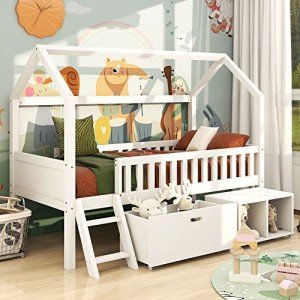Bunk Beds for Kids: A Comprehensive Guide
Bunk beds have actually been a popular option for kids's bed rooms for years. They use a space-saving option that takes full advantage of floor area, provides fun climbing up options, and is available in a range of styles that interest kids's creativities. This post checks out the advantages, considerations, designs, and safety functions connected with bunk beds for children.
Advantages of Bunk Beds
Bunk beds present numerous advantages that make them an attractive alternative for families. Here are some crucial benefits:
Space Saving
- Bunk beds allow two or more children to share a room without compromising space for play or other activities.
Affordable
- Acquiring a single bunk bed can be more cost-effective than buying two separate beds.
Enjoyable Factor
- Kids often see bunk beds as a fun place to sleep and play, cultivating a sense of experience.
Flexibility
- Bunk beds are available in various setups, including L-shaped, loft beds, and even convertible designs that can alter as children grow.
Company
- Many bunk beds come with built-in storage alternatives, such as shelves and drawers, helping keep rooms organized.
Secret Considerations Before Purchasing
Before purchasing a bunk bed, it's necessary to think about particular elements, such as:
- Space Requirements
Procedure the room to guarantee that there suffices vertical space, permitting for adequate headroom on the leading bunk. - Age of Your Children
Consider their age and maturity. Many producers suggest that children under 6 must not oversleep the top bunk due to security issues. - Weight Limit
It's vital to check the weight limits of the bunk bed for both the leading and bottom bunks to ensure security. - Style Preferences
Select a style that matches the space's design and the children's preferences. - Product
Bunk beds are readily available in different materials, such as wood or metal. Each has its advantages and disadvantages relating to sturdiness and visual appeals.
Designs of Bunk Beds
Bunk beds come in numerous designs to fit various looks and practical needs. Here's a list of some popular styles:
- Standard Bunk Beds
Classic stacked beds that include 2 beds built one above the other. - Loft Beds
A bed raised high off the ground, with space below for a desk, play location, or storage. - L-Shaped Bunk Beds
2 beds arranged in an L-shape, supplying more flooring space and a special style element. - Twin Over Full Bunk Beds
These alternatives include a twin bed on leading and a full-sized bed on the bottom, accommodating older kids or adults. - Triple Bunk Beds
Created for three children, these beds typically include three stacked beds, ideal for larger families.
Safety Features to Consider
Making sure the safety of children utilizing bunk beds is vital. Here are some security features to look for before making a purchase:
- Guardrails
A bunk bed should consist of tough guardrails on the top bunk to prevent unexpected falls. - Ladders
Ensure that the ladder is securely attached and simple for kids to browse safely. - Stability
Look for bunk beds with lower centers of gravity and large bases to offer much better stability. - Quality Construction
Choose beds made from durable products that fulfill security standards, such as ASTM (American Society for Testing and Materials) regulations.
FAQs About Bunk Beds
1. What age is appropriate for a top bunk?Generally, Sale Bunk Beds aged 6 and older are recommended for oversleeping the top bunk. 2. Are bunk beds safe for toddlers?Most professionals advise against
positioning toddlers in the leading bunk due to the
danger of falls and inappropriate ladder use. 3. Can bunk beds be separated?Many bunk beds are designed to be separated into two standalone beds,
supplying included versatility as kids grow
. 4. How do I keep a bunk bed?Regularly look for loose screws and use, keep bed mattress tidy, and guarantee that the bunk bed is
stable to lengthen its lifespan. 5.
Are there any unique mattress requirements for bunk beds?Yes, bed mattress for bunk beds must fit snugly without leaving gaps. Normally, thinner mattresses
(around 6 to 8 inches )are recommended for top bunks for safety. Bunk beds use a versatile, useful, and fun service for kids's sleeping plans, optimizing space while accommodating several kids in one room. By thinking about the important aspects
of design, security, and space, parents can make a notified choice when picking the best bunk bed for their children's needs. With the best care and maintenance, a bunk bed can be a beloved furniture piece that supplies years of usage and satisfaction for children. Summary Table of Bunk Bed Styles Style Description Best For Standard Bunk Beds Traditional style, two stacked beds Smaller sized spaces Loft Beds Elevated bed with open space below Research study or play areas L-Shaped Bunk Beds 2 beds in an L-shape
Included floor space Twin Over Full Twin on top,
| complete on bottom Accommodating older children Triple | ||||||
|---|---|---|---|---|---|---|
| Bunk Beds | Three stacked beds | Larger households By understanding | the various options offered, designated factors to consider for safety and functionality, and proper age standards, families | can select the perfect bunk bed that not | just boosts their home | however also makes sure a safe and |
| enjoyable sleeping environment | for their children.

|
